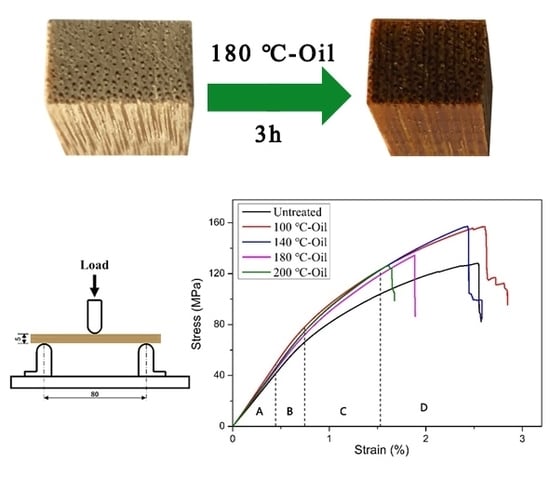Research on the Physico-Mechanical Properties of Moso Bamboo with Thermal Treatment in Tung Oil and Its Influencing Factors
Abstract
1. Introduction
2. Materials and Methods
2.1. Materials
2.2. Sample Preparation
2.3. Characterization
2.4. Density
2.5. Bending Mechanical Characterization
3. Results
3.1. Bending Mechanical Properties
3.2. Physical Property
3.3. Chemical Compositions
3.4. Crystallinity of Cellulose
4. Conclusions
Author Contributions
Funding
Acknowledgments
Conflicts of Interest
References
- Fang, C.H.; Jiang, Z.H.; Sun, Z.J.; Liu, H.R.; Zhang, X.B.; Zhang, R.; Fei, B.H. An overview on bamboo culm flattening. Constr. Build. Mater. 2018, 171, 65–74. [Google Scholar] [CrossRef]
- Zhang, J.Y.; Zhang, B.; Chen, X.F.; Mi, B.B.; Wei, P.L.; Fei, B.H.; Mu, X.D. Antimicrobial bamboo materials functionalized with Zno and graphene oxide nanocomposites. Materials 2017, 10, 239. [Google Scholar] [CrossRef]
- Kinumoto, T.; Matsumura, T.; Yamaguchi, K.; Matsuoka, M.; Tsumura, T.; Toyoda, M. Material processing of bamboo for use as a gas diffusion layer in proton exchange membrane fuel cells. ACS Sustain. Chem. Eng. 2015, 3, 1374–1380. [Google Scholar] [CrossRef]
- Scurlock, J.M.O.; Dayton, D.C.; Hames, B. Bamboo: An overlooked biomass resource? Biomass Bioenergy 2000, 19, 229–244. [Google Scholar] [CrossRef]
- Jain, S.; Kumar, R.; Jindal, U.C. Mechanical behaviour of bamboo and bamboo composite. J. Mater. Sci. 1992, 27, 4598–4604. [Google Scholar] [CrossRef]
- Kumar, A.; Vlach, T.; Laiblova, L.; Hrouda, M.; Kasal, B.; Tywoniak, J.; Hajek, P. Engineered bamboo scrimber: Influence of density on the mechanical and water absorption properties. Constr. Build. Mater. 2016, 127, 815–827. [Google Scholar] [CrossRef]
- He, M.X.; Wang, J.L.; Qin, H.; Shui, Z.X.; Zhu, Q.L.; Wu, B.; Tan, F.R.; Pan, K.; Hu, Q.C.; Dai, L.C.; et al. Bamboo: A new source of carbohydrate for biorefinery. Carbohydr. Polym. 2014, 111, 645–654. [Google Scholar] [CrossRef]
- Lee, C.H.; Yang, T.H.; Cheng, Y.W.; Lee, C.J. Effects of thermal modification on the surface and chemical properties of moso bamboo. Constr. Build. Mater. 2018, 178, 59–71. [Google Scholar] [CrossRef]
- Schmidt, O.; Wei, D.S.; Liese, W.; Wollenberg, E. Fungal degradation of bamboo samples. Holzforschung 2011, 65, 883–888. [Google Scholar] [CrossRef]
- Li, J.P.; Sun, Q.F.; Han, S.J.; Wang, J.; Wang, Z.; Jin, C.D. Reversibly light-switchable wettability between superhydrophobicity and superhydrophilicity of hybrid ZnO/bamboo surfaces via alternation of UV irradiation and dark storage. Prog. Org. Coat. 2015, 87, 155–160. [Google Scholar] [CrossRef]
- Anwar, U.M.K.; Paridah, M.T.; Hamdan, H.; Sapuan, S.M.; Bakar, E.S. Effect of curing time on physical and mechanical properties of phenolic-treated bamboo strips. Ind. Crop. Prod. 2009, 29, 214–219. [Google Scholar] [CrossRef]
- Fang, C.H.; Cloutier, A.; Blanchet, P.; Koubaa, A. Densification of wood veneers combined with oil-heat treatment. Part II: Hygroscopicity and mechanical properties. Bioresources 2012, 7, 925–935. [Google Scholar]
- Yang, T.H.; Lee, C.H.; Lee, C.J.; Cheng, Y.W. Effects of different thermal modification media on physical and mechanical properties of moso bamboo. Constr. Build. Mater. 2016, 119, 251–259. [Google Scholar] [CrossRef]
- Lee, S.H.; Ashaari, Z.; Lum, W.C.; Halip, J.A.; Ang, A.F.; Tan, L.P.; Chin, K.L.; Tahir, P.M. Thermal treatment of wood using vegetable oils: A review. Constr. Build. Mater. 2018, 181, 408–419. [Google Scholar] [CrossRef]
- Zhang, Y.M.; Yu, Y.L.; Yu, W.J. Effect of thermal treatment on the physical and mechanical properties of phyllostachys pubescen bamboo. Eur. J. Wood Wood Prod. 2012, 71, 61–67. [Google Scholar] [CrossRef]
- Korkut, S.; Akgul, M.; Dundar, T. The effects of heat treatment on some technological properties of Scots pine (Pinus sylvestris L.) wood. Bioresour. Technol. 2008, 99, 1861–1868. [Google Scholar] [CrossRef]
- Cheng, D.L.; Li, T.; Smith, G.D.; Xu, B.; Li, Y.J. The properties of Moso bamboo heat-treated with silicon oil. Eur. J. Wood Wood Prod. 2018, 76, 1273–1278. [Google Scholar] [CrossRef]
- Thanamongkollit, N.; Miller, K.R.; Soucek, M.D. Synthesis of UV-curable tung oil and UV-curable tung oil based alkyd. Prog. Org. Coat. 2012, 73, 425–434. [Google Scholar] [CrossRef]
- Yoo, Y.; Youngblood, J.P. Tung oil wood finishes with improved weathering, durability, and scratch performance by addition of cellulose nanocrystals. ACS Appl. Mater. Interfaces 2017, 9, 24936–24946. [Google Scholar] [CrossRef]
- Samadzadeh, M.; Boura, S.H.; Peikari, M.; Ashrafi, A.; Kasiriha, M. Tung oil: An autonomous repairing agent for self-healing epoxy coatings. Prog. Org. Coat. 2011, 70, 383–387. [Google Scholar] [CrossRef]
- Cheng, D.L.; Chen, L.J.; Jiang, S.X.; Zhang, Q.S. Oil uptake percentage in oil-heat-treated wood, its determination by soxhlet extraction, and its effects on wood compression strength parallel to the grain. Bioresources 2014, 9, 120–131. [Google Scholar] [CrossRef]
- Wang, J.P.; Matthews, M.L.; Williams, C.M.; Shi, R.; Yang, C.; Tunlaya-Anukit, S.; Chen, H.C.; Li, Q.; Liu, J.; Lin, C.Y.; et al. Improving Wood Properties for Wood Utilization through Multi-Omics Integration in Lignin Biosynthesis. Nat. Commun. 2018, 9, 1579. [Google Scholar] [CrossRef]
- ASTM International. Annual Book of ASTM Standards; ASTM International: West Conshohocken, PA, USA, 2009; Volume 4.10. [Google Scholar]
- Wegst, U.G.K.; Bai, H.; Saiz, E.; Tomsia, A.P.; Ritchie, R.O. Bioinspired structural materials. Nat. Mater. 2015, 14, 23–36. [Google Scholar] [CrossRef]
- Lv, H.F.; Chen, X.F.; Liu, X.M.; Fang, C.H.; Liu, H.R.; Zhang, B.; Fei, B.H. The vacuum-assisted microwave drying of round bamboos: Drying kinetics, color and mechanical property. Mater. Lett. 2018, 223, 159–162. [Google Scholar] [CrossRef]
- Hao, H.L.; Tam, L.H.; Lu, Y.; Lau, D. An atomistic study on the mechanical behavior of bamboo cell wall constituents. Compos. Part B Eng. 2018, 151, 222–231. [Google Scholar] [CrossRef]
- Yang, T.C.; Lee, T.Y. Effects of density and heat treatment on the physico-mechanical properties of unidirectional round bamboo stick boards (UBSBs) made of Makino bamboo (Phyllostachys makinoi). Constr. Build. Mater. 2018, 187, 406–413. [Google Scholar] [CrossRef]
- Boruvka, V.; Zeidler, A.; Holecek, T.; Dudik, R. Elastic and strength properties of heat-treated Beech and Birch wood. Forests 2018, 9, 197. [Google Scholar] [CrossRef]
- Srivaro, S.; Rattanarat, J.; Noothong, P. Comparison of the anatomical characteristics and physical and mechanical properties of oil palm and bamboo trunks. J. Wood Sci. 2018, 64, 186–192. [Google Scholar] [CrossRef]
- Korkut, S.; Hiziroglu, S. Effect of heat treatment on mechanical properties of hazelnut wood (Corylus columa L.). Mater. Des. 2009, 30, 1853–1858. [Google Scholar] [CrossRef]
- Dubey, M.K.; Pang, S.; Walker, J. Changes in chemistry, color, dimensional stability and fungal resistance of Pinus radiata D. Don wood with oil heat-treatment. Holzforschung 2012, 66, 49–57. [Google Scholar] [CrossRef]
- Korkut, D.S.; Hiziroglu, S. Experimental test of heat treatment effect on physical properties of Red Oak (Quercus falcate Michx.) and Southern Pine (Pinus taeda L.). Materials 2014, 7, 7314–7323. [Google Scholar] [CrossRef]
- Yang, X.J.; Li, S.H.; Xia, J.L.; Song, J.; Huang, K.; Li, M. Novel renewable resource-based UV-curable copolymers derived from myrcene and tung oil: Preparation, characterization and properties. Ind. Crop. Prod. 2015, 63, 17–25. [Google Scholar] [CrossRef]
- Fu, Q.L.; Ansari, F.; Zhou, Q.; Berglund, L.A. Wood nanotechnology for strong, mesoporous, and hydrophobic biocomposites for selective separation of oil/water mixtures. ACS Nano 2018, 12, 2222–2230. [Google Scholar] [CrossRef]
- Li, M.F.; Shen, Y.; Sun, J.K.; Bian, J.; Chen, C.Z.; Sun, R.C. Wet torrefaction of bamboo in hydrochloric acid solution by microwave heating. ACS Sustain. Chem. Eng. 2015, 3, 2022–2029. [Google Scholar] [CrossRef]
- Schonemann, A.; Edwards, H.G.M. Raman and FTIR microspectroscopic study of the alteration of Chinese tung oil and related drying oils during ageing. Anal. Bioanal. Chem. 2011, 400, 1173–1180. [Google Scholar] [CrossRef]
- Meng, F.D.; Yu, Y.L.; Zhang, Y.M.; Yu, W.J.; Gao, J.M. Surface chemical composition analysis of heat-treated bamboo. Appl. Surf. Sci. 2016, 371, 383–390. [Google Scholar] [CrossRef]
- Kol, H.Ş.; Sefil, Y. The thermal conductivity of fir and beech wood heat treated at 170, 180, 190, 200, and 212 °C. J. Appl. Polym. Sci. 2011, 121, 2473–2480. [Google Scholar] [CrossRef]
- Zhang, S.Y.; Wang, C.G.; Fei, B.H.; Yu, Y.; Cheng, H.T.; Tian, G.L. Mechanical function of lignin and hemicelluloses in wood cell wall revealed with microtension of single wood fiber. Bioresources 2013, 8, 2376–2385. [Google Scholar] [CrossRef]
- Poletto, M.; Ornaghi, H.L.; Zattera, A.J. Native cellulose: Structure, characterization and thermal properties. Materials 2014, 7, 6105–6119. [Google Scholar] [CrossRef]
- Gibson, L.J. The hierarchical structure and mechanics of plant materials. J. R. Soc. Interface 2012, 9, 2749–2766. [Google Scholar] [CrossRef]
- Flores, E.I.S.; Friswell, M.I. Multi-scale finite element model for a new material inspired by the mechanics and structure of wood cell-walls. J. Mech. Phys. Solids 2012, 60, 1296–1309. [Google Scholar] [CrossRef]
- Bjurhager, I.; Olsson, A.M.; Zhang, B.; Gerber, L.; Kumar, M.; Berglund, L.A.; Burgert, I.; Sundberg, B.; Salmen, L. Ultrastructure and mechanical properties of populus wood with reduced lignin content caused by transgenic hydroxylase. Biomacromolecules 2010, 11, 2359–2365. [Google Scholar] [CrossRef]
- Jiang, F.; Li, T.; Li, Y.J.; Zhang, Y.; Gong, A.; Dai, J.Q.; Hitz, E.; Luo, W.; Hu, L.B. Wood-based nanotechnologies toward sustainability. Adv. Mater. 2018, 30, 1703453. [Google Scholar] [CrossRef]
- Jia, C.; Bian, H.Y.; Gao, T.T.; Jiang, F.; Kierzewski, I.M.; Wang, Y.L.; Yao, Y.G.; Chen, L.H.; Shao, Z.Q.; Zhu, J.Y.; et al. Thermally stable cellulose nanocrystals toward high-performance 2d and 3d nanostructures. ACS Appl. Mater. Interfaces 2017, 9, 28922–28929. [Google Scholar] [CrossRef]
- Chen, W.S.; Yu, H.P.; Liu, Y.X.; Hai, Y.F.; Zhang, M.X.; Chen, P. Isolation and characterization of cellulose nanofibers from four plant cellulose fibers using a chemical-ultrasonic process. Cellulose 2011, 18, 433–442. [Google Scholar] [CrossRef]
- Youssefian, S.; Rahbar, N. Molecular origin of strength and stiffness in bamboo fibrils. Sci. Rep. 2015, 5, 11116. [Google Scholar] [CrossRef]
- Zhang, H.H.; Shao, H.L.; Hu, X.C. Effect of heat treatment on the structure and properties of lyocell fibers. J. Appl. Polym. Sci. 2006, 101, 1738–1743. [Google Scholar] [CrossRef]
- Mohebby, B.; Kevily, H.; Kazemi-Najafi, S. Oleothermal modification of fir wood with a combination of soybean oil and maleic anhydride and its effects on physico-mechanical properties of treated wood. Wood Sci. Technol. 2014, 48, 797–809. [Google Scholar] [CrossRef]
- Lee, S.H.; Ashaari, Z.; Ang, A.F.; Abdul Halip, J.; Lum, W.C.; Dahali, R.; Halis, R. Effects of two-step post heat-treatment in palm oil on the properties of oil palm trunk particleboard. Ind. Crop. Prod. 2018, 116, 249–258. [Google Scholar] [CrossRef]
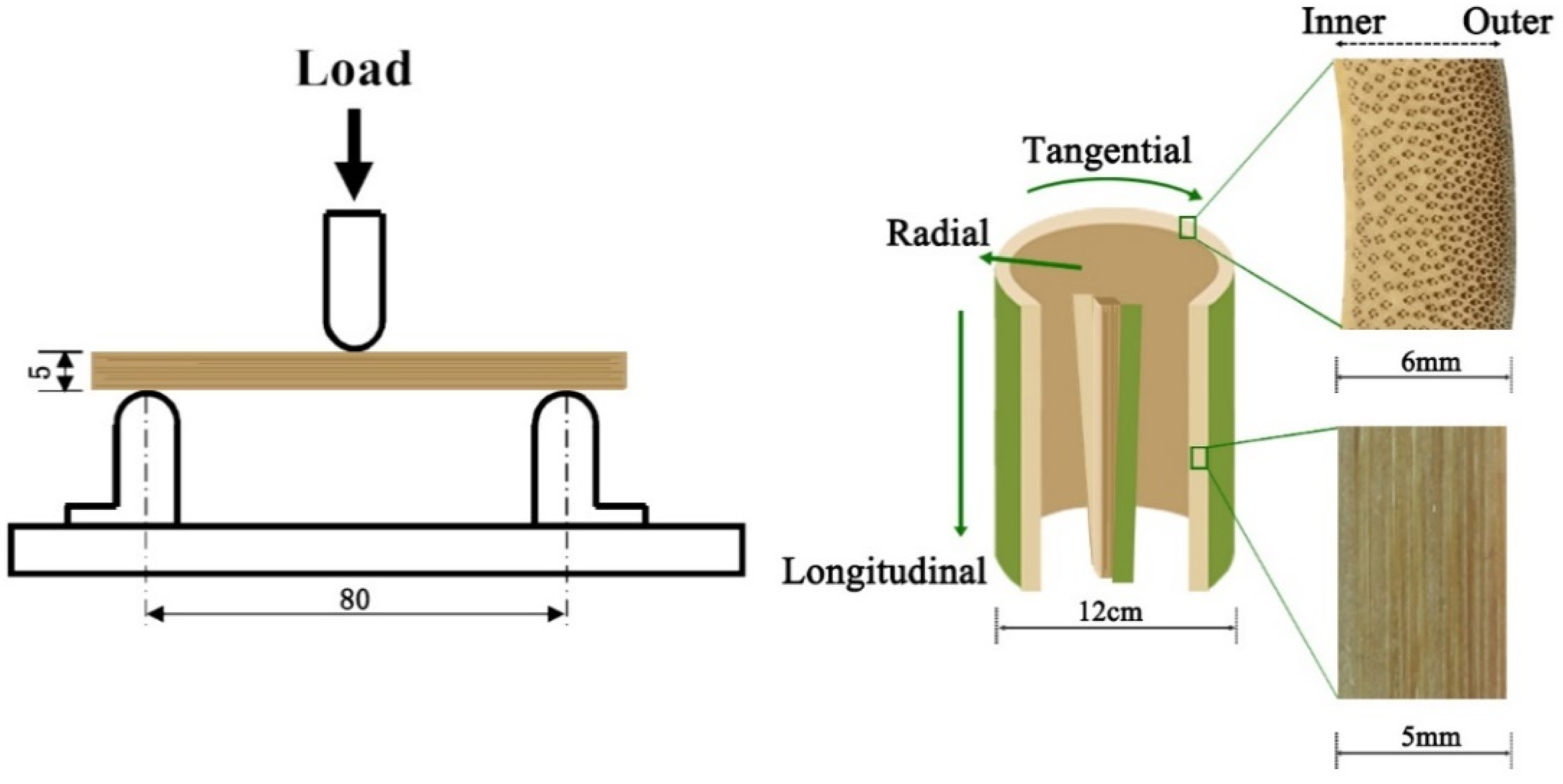
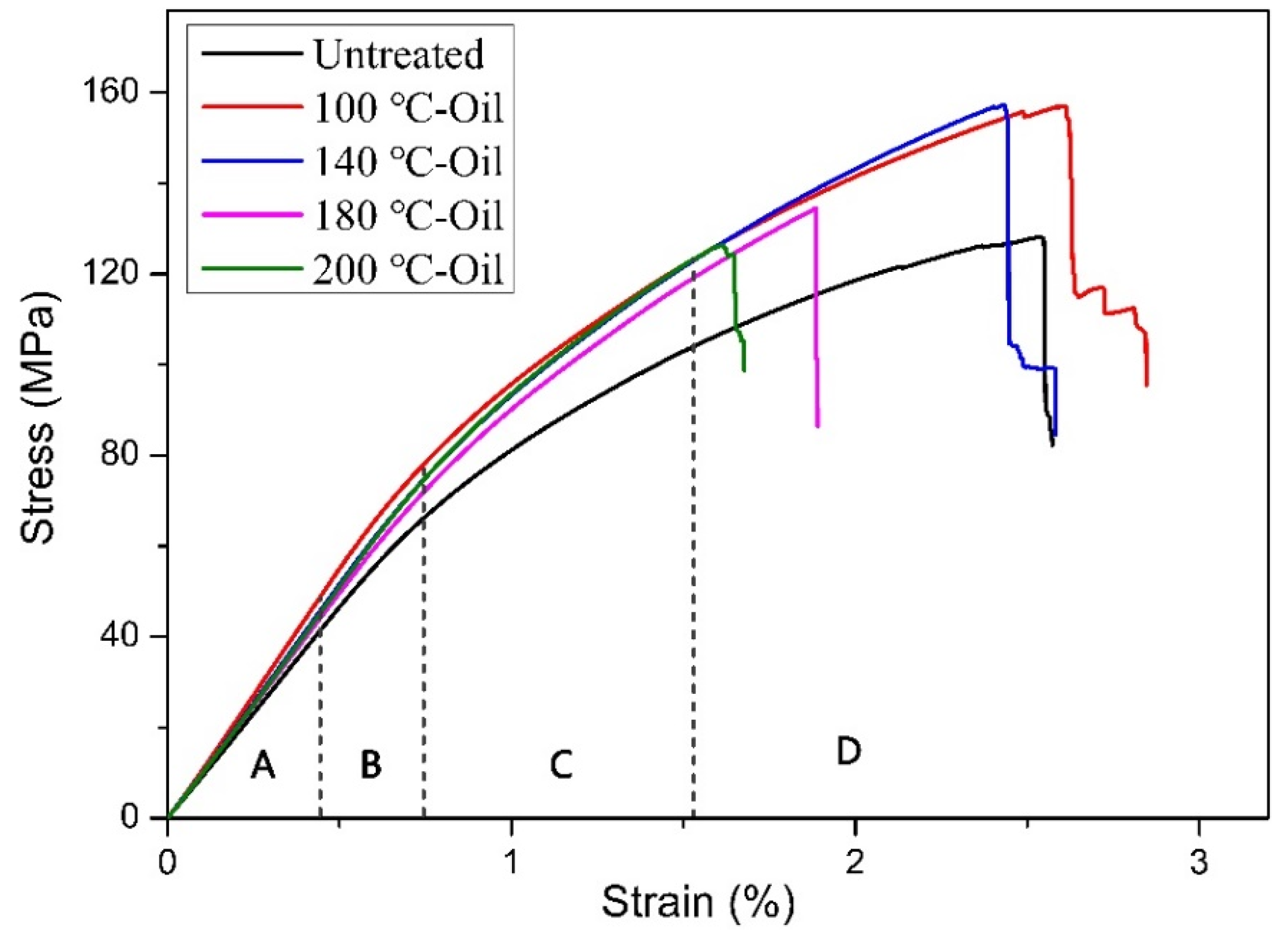
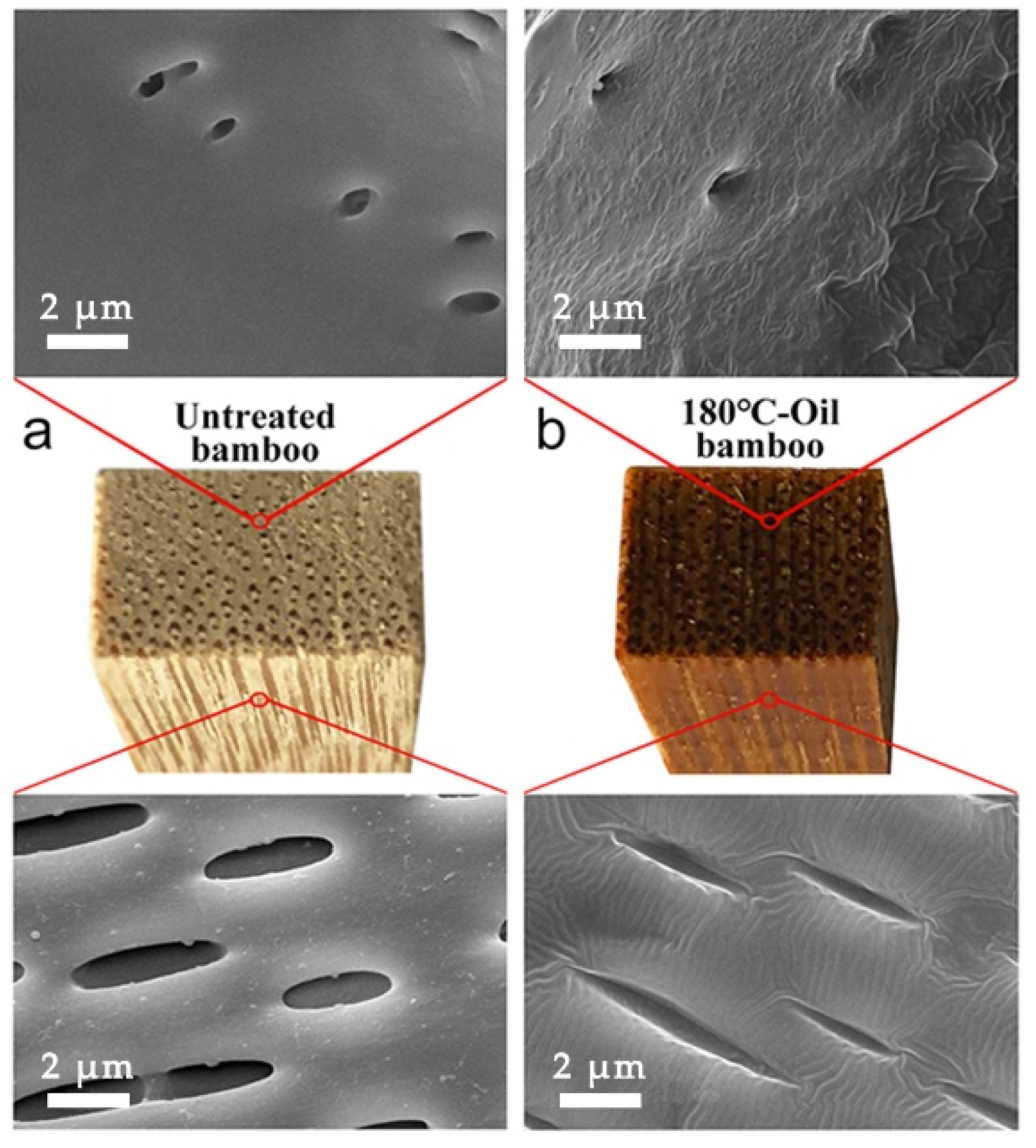
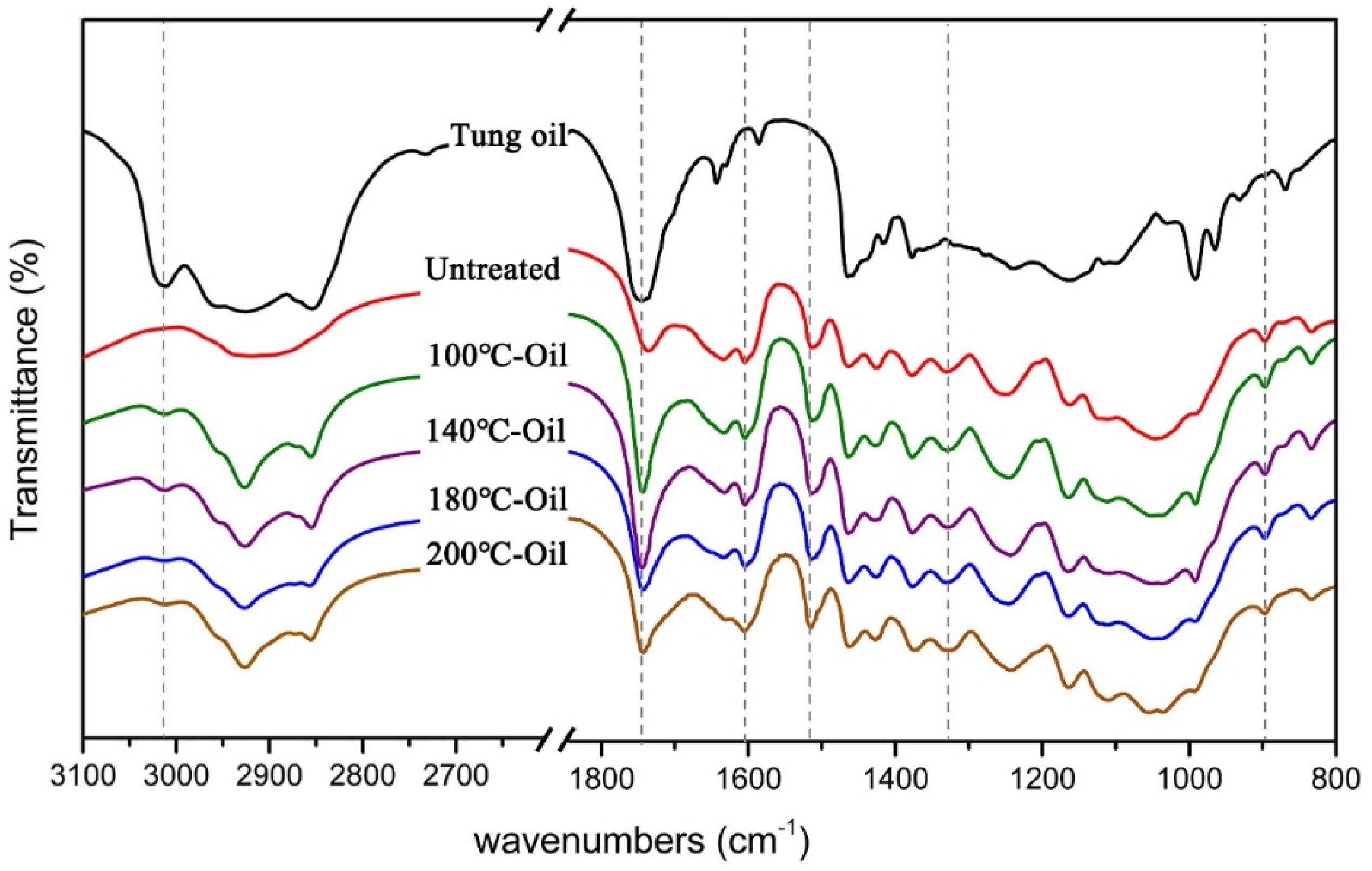

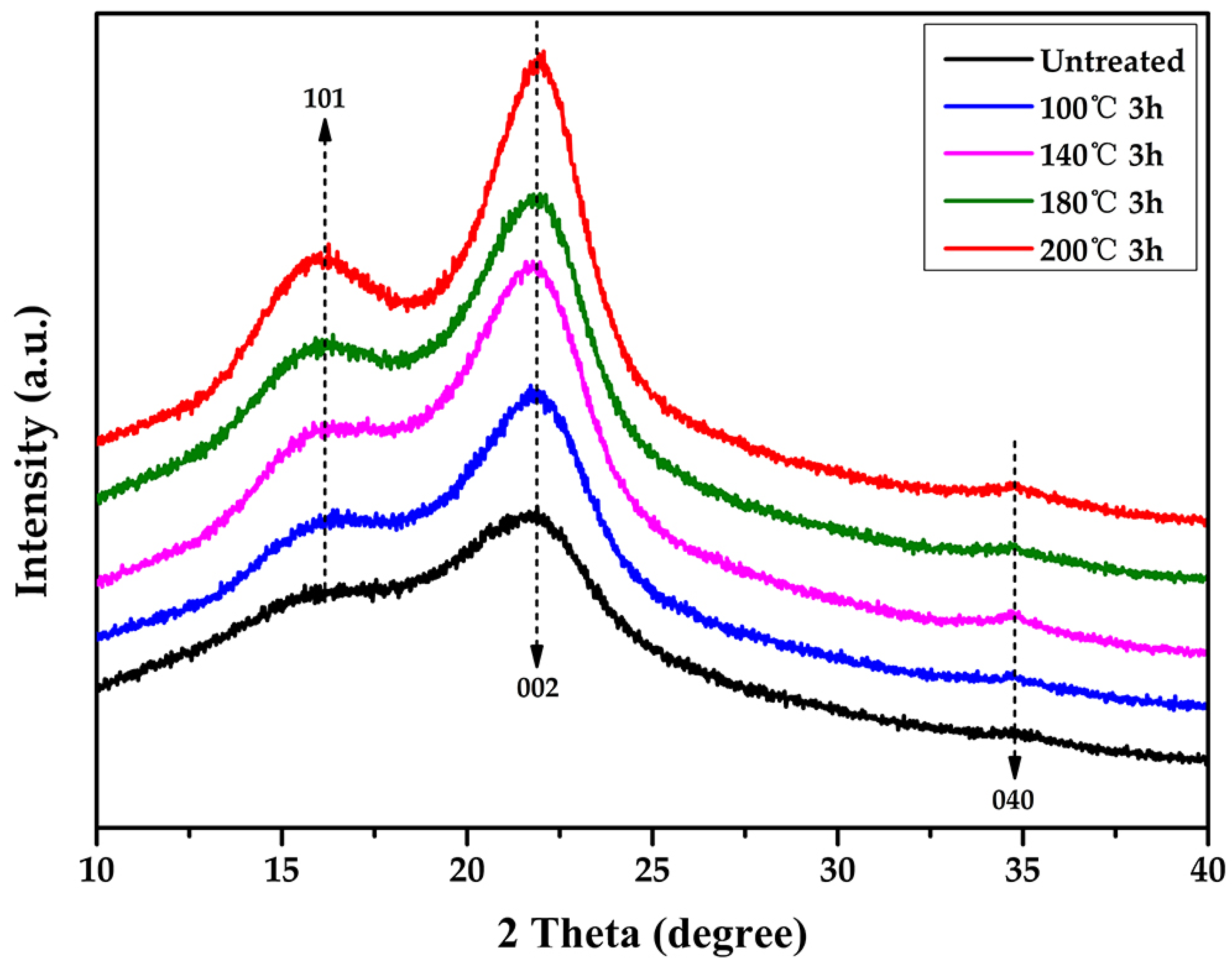
| Treatment (°C) | Density (g/cm3) | Crystallinity Index (CrI / %) | Bending Mechanical Properties | |||
|---|---|---|---|---|---|---|
| MOE (GPa) | MOR (MPa) | Ultimate Stress (MPa) | Ultimate Strain (%) | |||
| Untreated | 0.64 (0.02) | 24.5 | 6.92 (0.49) | 106.39 (5.82) | 123.62 (6.72) | 2.55 (0.08) |
| 100 | 0.69 (0.02) | 33.3 | 7.60 (0.47) | 128.14 (4.80) | 149.84 (9.08) | 2.71 (0.15) |
| 140 | 0.66 (0.02) | 34.0 | 7.51 (0.54) | 128.02 (7.90) | 148.69 (10.16) | 2.43 (0.12) |
| 180 | 0.63 (0.03) | 35.5 | 7.24 (0.67) | 112.01 (8.68) | 130.78 (11.55) | 1.83 (0.11) |
| 200 | 0.60 (0.02) | 44.4 | 7.51 (0.60) | 107.88 (8.20) | 129.48 (10.70) | 1.66 (0.10) |
© 2019 by the authors. Licensee MDPI, Basel, Switzerland. This article is an open access article distributed under the terms and conditions of the Creative Commons Attribution (CC BY) license (http://creativecommons.org/licenses/by/4.0/).
Share and Cite
Tang, T.; Chen, X.; Zhang, B.; Liu, X.; Fei, B. Research on the Physico-Mechanical Properties of Moso Bamboo with Thermal Treatment in Tung Oil and Its Influencing Factors. Materials 2019, 12, 599. https://doi.org/10.3390/ma12040599
Tang T, Chen X, Zhang B, Liu X, Fei B. Research on the Physico-Mechanical Properties of Moso Bamboo with Thermal Treatment in Tung Oil and Its Influencing Factors. Materials. 2019; 12(4):599. https://doi.org/10.3390/ma12040599
Chicago/Turabian StyleTang, Tong, Xiufang Chen, Bo Zhang, Xianmiao Liu, and Benhua Fei. 2019. "Research on the Physico-Mechanical Properties of Moso Bamboo with Thermal Treatment in Tung Oil and Its Influencing Factors" Materials 12, no. 4: 599. https://doi.org/10.3390/ma12040599
APA StyleTang, T., Chen, X., Zhang, B., Liu, X., & Fei, B. (2019). Research on the Physico-Mechanical Properties of Moso Bamboo with Thermal Treatment in Tung Oil and Its Influencing Factors. Materials, 12(4), 599. https://doi.org/10.3390/ma12040599




